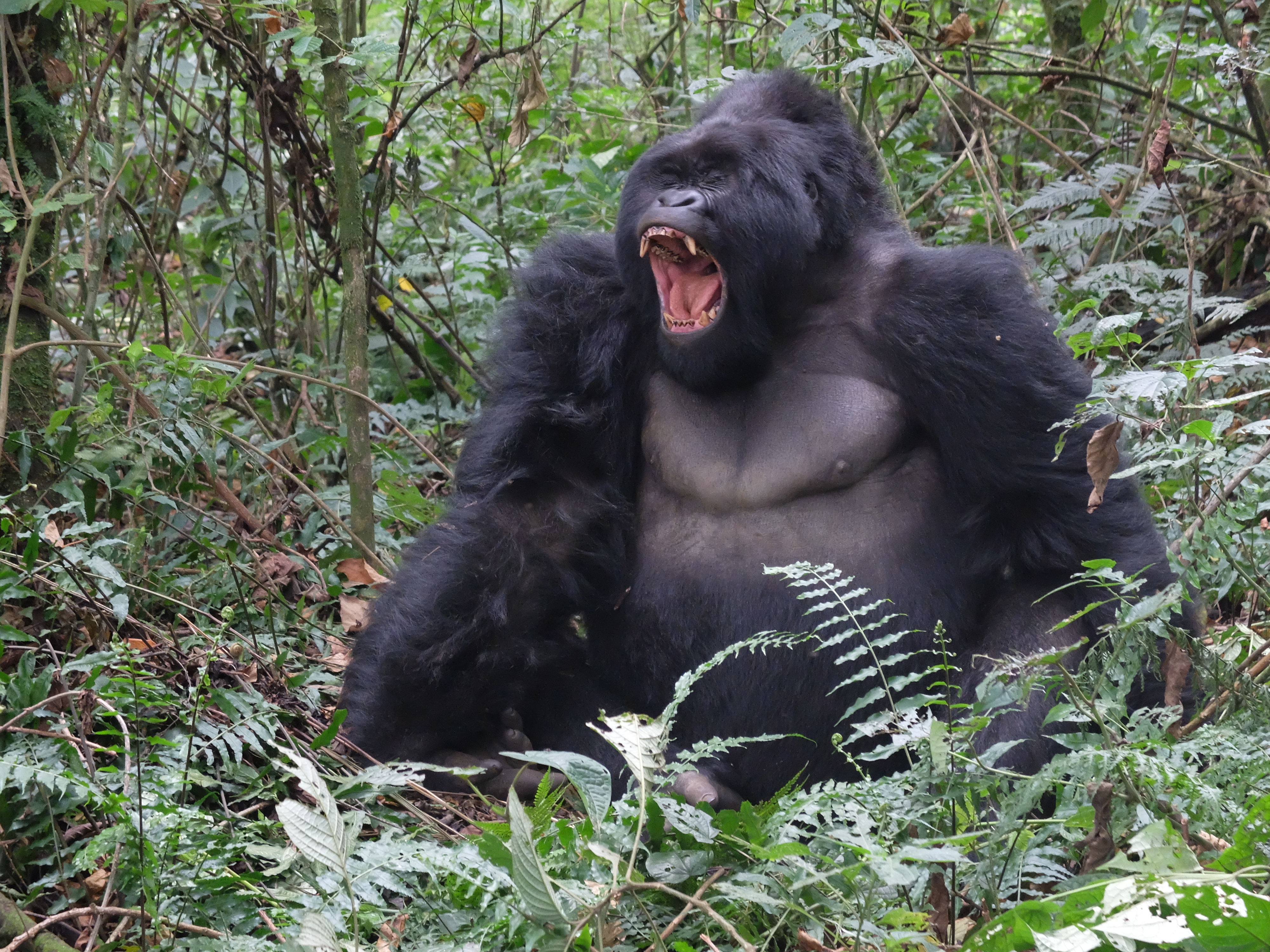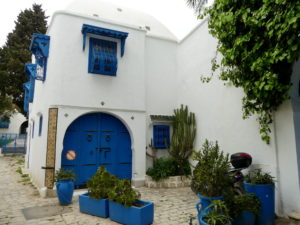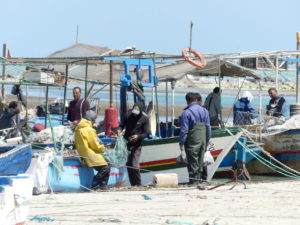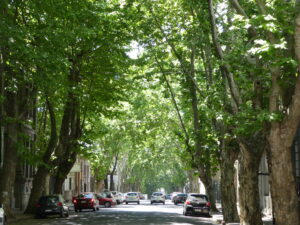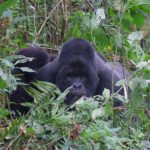
Virunga. Perhaps you have read about this natural treasure and its notable inhabitants, the endangered gorilla. Perhaps you have seen documentaries or the movie, Gorillas in the Mist. We were willing to venture into the Congo, experience the Virunga forest directly and spend an hour with one family of these imposing and impressive apes. (Amazingly, the same day, we saw four other primates in the wild – colobus and vervet monkeys, babboons, and the hard-to-find chimpanzees.)
An international consortium now protects Virunga (and the tourists) from Congolese civil conflicts and poachers, while sharing money with the local communities so they care about protection as well. Wildly successful, the consortium has halted most poaching, so the gorilla population across the Virunga Mountains doubled in just 7 years to 880 per the last census. When Dian Fossey did her work decades ago, only 250 of these close relatives of ours remained.
Act 1: Prelude to the morning of the apes

In the Democratic Republic of Congo (DRC) the formalities seem endless: socializing amid the small group, signing and checking permits, testing for fever with a pointer that looks like a small hairdryer, and finally the introduction of the three families of habituated gorillas that the three divisions of our group will visit. At least, this was not the jamboree of 100s of tourists that characterizes the Rwandan startup in Volcanoes National Park.
Habituated families have been repeatedly exposed to natives and rangers, and over time accustomed themselves to the presence of human strangers. That does make the vulnerable to poachers, whom the rangers have otherwise managed to control, but also guarantees sightings for visitors and ensures the revenue that sustains their protection as well as the village communities’ stake in success. If you think hard about the experience, it’s what we have started calling the semi-wild, a bit of a zoo, and a bit of a safari wild adventure, but not quite either.
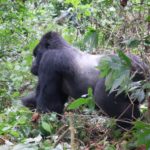
Rugondo, our gorilla family, comprised 10 apes, four of whom were the striking male silverbacks (at the age of 12, the silver striping on the back develops, like a sign of maturity). This actually was a group in which when the now dominant male and son of Rugondo took charge.
Our sub-group of six visitors then trudged through rows and rows of potatoes and sorghum for an hour, mainly to move faster to where the trackers had located our gorilla family. Even the trails within the Virunga forest are narrow, slow, thick with low bushes and trees a-kilter, and often just a twisting maze of vines to trip you up. But the long, dreary hour in the fields adjacent to the forest make us think of a new movie, Gorillas in the Wheat.
Ten minutes after we enter the forest, we stop. Our guide and tracker/vine hacker confer. We retreat a few 100 meters, discard our back packs and enter a natural amphitheatre filled with gorillas.
Act 2: The fourth wall
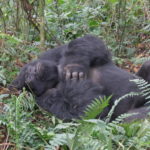
At first, a bit of a rumble between the dominant male silverback and another male, some grumbling and movement among the gorillas – details four adult silverbacks,

Then they start to take a catnap, or ape-nap I suppose, completely indifferent to us. Occasionally they would open their eyes and take a quick look at the odd humans, but without much apparent interest.
The six of us formed a line-up, a wall, flanked by two guides, as if we were the audience at a performance by the gorillas. They are only a few meters apart from us. But it’s a sleepy-time performance as they all start sacking out on the ground, most on their backs, some on their sides, just like, well, people.

Meanwhile, everyone in our group of 6 visitors is taking photos or just admiring the huge beasts, their grandeur, their massive hands and feet, their glowering look.
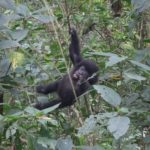
For another twenty minutes, we are all occupied with novelty and the splendor of these animals, and then nothing much happens, a grunt, a fart, one gorilla turns over in his nap. The only movement is a six month baby gorilla who starts to climb a sprig of a tree, at most a half meter above the ground, and then grabs for other branches, often futilely, but continues on and on unfrustrated.

As he climbs another shoot, that one promptly plops him over atop one of the larger silverbacks. Unbothered, the silverback snorts a bit, rolls over and then snoozes some more. For a half hour, we are all captivated by the baby’s restless experimentation with the physics of climbing.
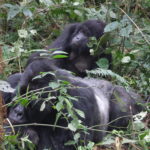
He lopes past his aunt, who tries to corral him and hug him close, as another baby had been enfolded during this snooze. Nothing doing, as he’s off again, colliding into the dominant male and then climbing more shoots at the front of the stage.
His mother shows up, not to care for the baby, but to drape caressingly over the father, the dominant male, to snooze peaceably together.
Act 3: The Vanishing
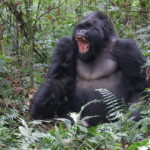
The females turn over first and sit up, heading off to the left. Several juveniles prowl back and forth, stage left and right, getting a bit close to breaking the fourth wall, , so the guide taps his machete in a gentle warning.
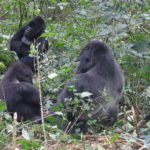
The big silverbacks rise impressively on their haunches, eyes a bit bleary and offer us some prodigious yawns that would be quite fearsome in other circumstances. We can see all ten now, some obscured in the thick underbrush toward the back of the stage, silently communicating as they awaken. Suddenly they start to disappear in the underbrush, quieter despite their bulk than we could ever move through the thick growth. Finally, the large male ambles away from us and disappears as well. All apparently as indifferent to us as when they were asleep.
Other people had varying experiences, observing different kinds of behavior by these magnificent apes – other gorilla families were more active in eating and interacting, We realized that’s why some trek to the apes over and over again (one did this 3 times in one visit, another had logged 7 over time). But we were satisfied with our less dramatic, more amusing and quieter opportunity to admire these stunning relatives in the evolutionary chain.
(Also, for more pictures from Rwanda and DRC, CLICK HERE to view the slideshow at the end of the itinerary page.)


